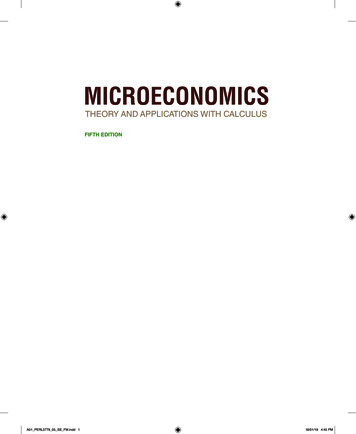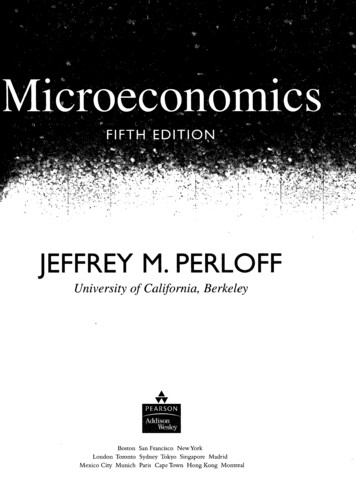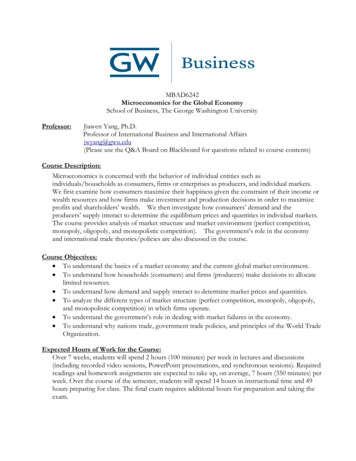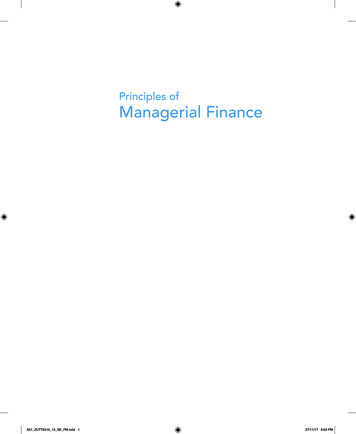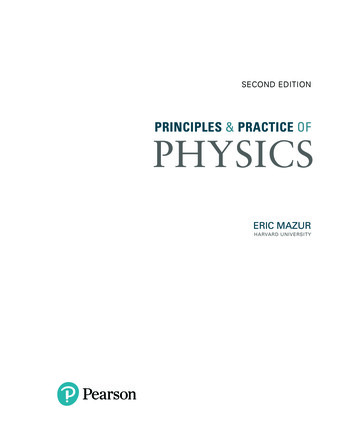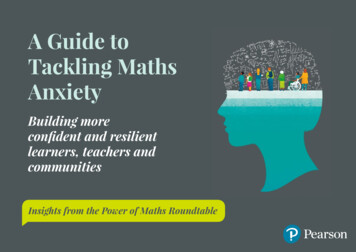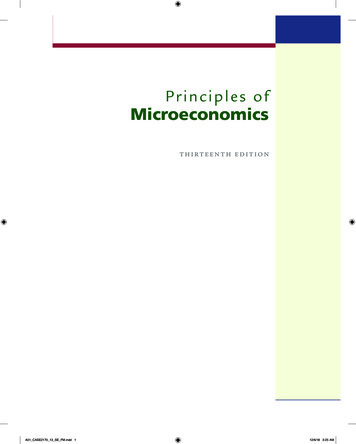
Transcription
Pr inciples ofMicroeconomicsTHIRTEENTH EDITIONA01 CASE2170 13 SE FM.indd 112/6/18 3:25 AM
A01 CASE2170 13 SE FM.indd 212/6/18 3:25 AM
Pr inciples ofMicroeconomicsKarl E. CaseWellesley CollegeRay C. FairYale UniversitySharon M. OsterYale UniversityTHIRTEENTH EDITIONA01 CASE2170 13 SE FM.indd 312/6/18 3:25 AM
Vice President, Business, Economics, and UKCourseware: Donna BattistaDirector of Portfolio Management: AdrienneD’AmbrosioSpecialist Portfolio Manager: David AlexanderEditorial Assistant: Nicole NedwidekVice President, Product Marketing: Roxanne McCarleySenior Product Marketer: Carlie MarvelProduct Marketing Assistant: Marianela SilvestriManager of Field Marketing, Business Publishing:Adam GoldsteinField Marketing Manager: Ashley BryanVice President, Production and Digital Studio, Artsand Business: Etain O'DeaDirector, Production and Digital Studio, Businessand Economics: Ashley SantoraManaging Producer, Business: Alison KalilContent Producer: Carolyn PhilipsOperations Specialist: Carol MelvilleDesign Lead: Kathryn FootManager, Learning Tools: Brian SuretteSenior Learning Tools Strategist: Emily BibergerManaging Producer, Digital Studio and GLP: JamesBatemanManaging Producer, Digital Studio: Diane LombardoDigital Studio Producer: Melissa HonigDigital Studio Producer: Alana ColesDigital Content Team Lead: Noel LotzDigital Content Project Lead: Noel LotzFull Service Project Management: Jennifer Gavigan,Integra Software ServicesInterior Design: Integra Software Services, Inc.Cover Design: Integra Software Services, Inc.Cover Art: Integra Software Services, Inc.Printer/Binder: LSC Communications, Inc.Cover Printer: LSC Communications, Inc.Copyright 2020, 2017, 2014 by Pearson Education, Inc. or its affiliates. All Rights Reserved. Manufacturedin the United States of America. This publication is protected by copyright, and permission should be obtained fromthe publisher prior to any prohibited reproduction, storage in a retrieval system, or transmission in any form or by anymeans, electronic, mechanical, photocopying, recording, or otherwise. For information regarding permissions, requestforms, and the appropriate contacts within the Pearson Education Global Rights and Permissions department, pleasevisit www.pearsoned.com/permissions/.Acknowledgments of third-party content appear on page 495, which constitutes an extension of this copyright page.PEARSON, ALWAYS LEARNING, and MYLAB are exclusive trademarks owned by Pearson Education, Inc. or its affiliates in the U.S. and/or other countries.Unless otherwise indicated herein, any third-party trademarks, logos, or icons that may appear in this work are theproperty of their respective owners, and any references to third-party trademarks, logos, icons, or other trade dress arefor demonstrative or descriptive purposes only. Such references are not intended to imply any sponsorship, endorsement, authorization, or promotion of Pearson’s products by the owners of such marks, or any relationship between theowner and Pearson Education, Inc., or its affiliates, authors, licensees, or distributors.Library of Congress Cataloging-in-Publication DataNames: Case, Karl E., author. Fair, Ray C., author. Oster, Sharon M.,author.Title: Principles of microeconomics / [Karl E. Case, Ray C. Fair, Sharon M. Oster].Description: [13th edition]. Upper Saddle River, NJ : Pearson, [2019] Includes index.Identifiers: LCCN 2018018211 ISBN 9780135162170 (softcover)Subjects: LCSH: Microeconomics.Classification: LCC HB172 .C36 2019 DDC 338.5—dc23LC record available at https://lccn.loc.gov/201801821110 9 8 7 6 5 4 3 2 1ISBN 10:0-13-516217-3ISBN 13: 978-0-13-516217-0A01 CASE2170 13 SE FM.indd 412/6/18 3:25 AM
This edition is dedicated to Chip Case, a wonderful colleague and friend. He was the inspiration for this textbooksome 30 years ago, and he served as an inspiration to study economics for thousands of students.A01 CASE2170 13 SE FM.indd 512/6/18 3:25 AM
About the AuthorsKarl E. Case, who passed away in July, 2016, was a Professor of Economics Emeritus at WellesleyCollege where he taught for 34 years, serving several tours of duty as Department Chair. He wasa Senior Fellow at the Joint Center for Housing Studies at Harvard University and a founding partner in the real estate research firm of Fiserv Case Shiller Weiss, which produces the S&P CaseShiller Index of home prices. He served as a member of the Index Advisory Committee of Standard and Poor’s, and on the Academic Advisory Board of the Federal Reserve Bank of Boston.Professor Case received his B.A. from Miami University in 1968, spent three years on activeduty in the Army, and received his Ph.D. in Economics from Harvard University in 1976.Professor Case’s research was in the areas of real estate, housing, and public finance. Heauthored or coauthored five books, including Principles of Economics, Economics and Tax Policy, andProperty Taxation: The Need for Reform, and published numerous articles in professional journals,focused on real estate markets and prices.Chip, as he was known to his many friends and colleagues, contributed to this textbookthroughout its many editions. In his honor and with respect for his substantial contributions tothe text and the discipline of economics, his co-authors plan to keep his name on the text for allfuture editions.Ray C. Fair is Professor of Economics at Yale University. He is a member of the Cowles Foundation at Yale and a Fellow of the Econometric Society. He received a B.A. in Economicsfrom Fresno State College in 1964 and a Ph.D. in Economics from MIT in 1968. He taught atPrinceton University from 1968 to 1974. Professor Fair has taught introductory and intermediate macroeconomics at Yale since 1974. He has also taught graduate courses in macroeconomictheory and macroeconometrics.Professor Fair’s research has primarily been in the areas of macroeconomics and econometrics, with particular emphasis on macroeconometric model building. He has alsodone work in the areas of finance, voting behavior, and aging in sports. His publications include Specification, Estimation, and Analysis of Macroeconometric Models (Harvard Press, 1984); Testing Macroeconometric Models (Harvard Press, 1994); Estimating How the Macroeconomy Works (HarvardPress, 2004), and Predicting Presidential Elections and Other Things (Stanford University Press, 2012).Professor Fair’s U.S. and multicountry models are available for use on the Internet free ofcharge. The address is http://fairmodel.econ.yale.edu. Many teachers have found that havingstudents work with the U.S. model on the Internet is a useful complement to an introductorymacroeconomics course.Sharon M. Oster is the Frederic Wolfe Professor of Economics and Management and formerDean of the Yale School of Management. Professor Oster joined Case and Fair as a coauthor in theninth edition of this book. Professor Oster has a B.A. in Economics from Hofstra University anda Ph.D. in Economics from Harvard University.Professor Oster’s research is in the area of industrial organization. She has worked on problems of diffusion of innovation in a number of different industries, on the effect of regulations onbusiness, and on competitive strategy. She has published a number of articles in these areas andis the author of several books, including Modern Competitive Analysis and The Strategic Managementof Nonprofits.Prior to joining the School of Management at Yale, Professor Oster taught for a number ofyears in Yale’s Department of Economics. In the department, Professor Oster taught introductory and intermediate microeconomics to undergraduates as well as several graduate coursesin industrial organization. Since 1982, Professor Oster has taught primarily in the ManagementSchool, where she teaches the core microeconomics class for MBA students and a course in thearea of competitive strategy. Professor Oster also consults widely for businesses and nonprofitorganizations and has served on the boards of several publicly traded companies and nonprofitorganizations.viA01 CASE2170 13 SE FM.indd 612/6/18 3:25 AM
Brief ContentsPART I Introduction to Economics15 Monopolistic Competition 31211 The Scope and Method of Economics 12 The Economic Problem: Scarcity and Choice 233 Demand, Supply, and Market Equilibrium4 Demand and Supply Applications5 ElasticityPART II4316 Externalities, Public Goods, and CommonResources 32717 Uncertainty and Asymmetric Information18 Income Distribution and Poverty7435036619 Public Finance: The Economics of Taxation92The World Economy 412PART IVThe Market System 1133906 Household Behavior and Consumer Choice 11620 International Trade, Comparative Advantage,and Protectionism 4127 The Production Process: The Behaviorof Profit-Maximizing Firms 14521 Economic Growth in Developing EconomiesPART V8 Short-Run Costs and Output Decisions 1689 Long-Run Costs and Output Decisions 18810 Input Demand: The Labor and Land Markets21211 Input Demand: The Capital Market and the Investment Decision 22812 General Equilibrium and the Efficiency of PerfectCompetition 249PART IIIMethodology43645322 Critical Thinking about Research 453GlossaryIndex468477Photo Credits495 arket Imperfections and theMRole of Government 26413 Monopoly and Antitrust Policy26414 Oligopoly 289viiA01 CASE2170 13 SE FM.indd 712/6/18 3:25 AM
ContentsPART I Introduction to Economics 11The Scope and Methodof Economics 112 Review Terms and Concepts13Problems 13 Appendix: How to Read and Understand Graphs 15238Summary 38 Review Terms and Concepts 39 Problems 39Why Study Economics? 2To Learn a Way of Thinking 2ECONOMICS IN PRACTICE Rainfall and Schoolingin India 3ECONOMICS IN PRACTICE Majoring in EconomicsMakes You Less Vulnerable to a Recession! 4To Understand Society 4To Be an Informed Citizen 5The Scope of Economics 5Microeconomics and Macroeconomics 5ECONOMICS IN PRACTICE iPod and the World 6The Diverse Fields of Economics 7The Method of Economics 8Theories and Models 8ECONOMICS IN PRACTICE Does Your RoommateMatter for Your Grades? 10Economic Policy 10An Invitation 12Economic Skills and Economics as a Career 12SummaryMixed Systems, Markets, and GovernmentsLooking Ahead 38The Economic Problem: Scarcityand Choice 23Scarcity, Choice, and Opportunity Cost 24Scarcity and Choice in a One-PersonEconomy 24Scarcity and Choice in an Economy of Two orMore 25ECONOMICS IN PRACTICE Frozen Foods andOpportunity Costs 26The Production Possibility Frontier 29The Economic Problem 35ECONOMICS IN PRACTICE Trade-Offs among theRich and Poor 36Economic Systems and the Roleof Government 36Command Economies 36Laissez-Faire Economies: The Free Market 373Demand, Supply, and MarketEquilibrium 43Firms and Households: The BasicDecision-Making Units 44Input Markets and Output Markets: The CircularFlow 44Demand in Product/Output Markets 46Changes in Quantity Demanded versus Changesin Demand 46Price and Quantity Demanded: The Lawof Demand 47Other Determinants of Household Demand 50ECONOMICS IN PRACTICE Have You Bought ThisTextbook? 51ECONOMICS IN PRACTICE On Sunny Days PeopleBuy Convertibles! 52Shift of Demand versus Movement alonga Demand Curve 53From Household Demand to Market Demand 54Supply in Product/Output Markets 56Price and Quantity Supplied: The Law of Supply 57Other Determinants of Supply 58Shift of Supply versus Movement along a SupplyCurve 59From Individual Supply to Market Supply 60Market Equilibrium 61Excess Demand 61Excess Supply 63Market Equilibrium with Equations 64Changes in Equilibrium 64ECONOMICS IN PRACTICE Quinoa 67Demand and Supply in Product Markets:A Review 67ECONOMICS IN PRACTICE Why Do the Pricesof Newspapers Rise? 68Looking Ahead: Markets and the Allocationof Resources 69Summary 69 Review Terms and Concepts 70 Problems 71viiiA01 CASE2170 13 SE FM.indd 812/6/18 3:25 AM
ixContents4Demand and SupplyApplications 74The Price System: Rationing and AllocatingResources 75Price Rationing 75Constraints on the Market and AlternativeRationing Mechanisms 77ECONOMICS IN PRACTICE Why is My Hotel RoomSo Expensive? A Tale of Hurricane Sandy 79Prices and the Allocation of Resources 81Price Floor 81Supply and Demand Analysis: Tariffs (Tax) 82ECONOMICS IN PRACTICE The Price Mechanismat Work for Shakespeare 83Supply and Demand and MarketEfficiency 84Consumer Surplus 84Producer Surplus 85Competitive Markets Maximize the Sumof Producer and Consumer Surplus 86Potential Causes of Deadweight Loss FromUnder- and Overproduction 87Looking Ahead 88Summary 88 Review Terms and Concepts 88 Problems 895Elasticity92Price Elasticity Of Demand 93Slope and Elasticity 93Types of Elasticity 94Calculating Elasticities 95Calculating Percentage Changes 95Elasticity Is a Ratio of Percentages 96The Midpoint Formula 96Elasticity Changes along a Straight-Line DemandCurve 97Elasticity and Total Revenue 100The Determinants of Demand Elasticity 101Availability of Substitutes 101The Importance of Being Unimportant 101Luxuries versus Necessities 101ECONOMICS IN PRACTICE Elasticitiesat a Delicatessen in the Short Run andLong Run 102The Time Dimension 102Other Important Elasticities 103Income Elasticity of Demand 103Cross-Price Elasticity of Demand 103Elasticity of Supply 104A01 CASE2170 13 SE FM.indd 9ECONOMICS IN PRACTICE Tax Rates and Migrationin Europe 105What Happens when We Raise Taxes:Using Elasticity 105Looking Ahead 107Summary 107 Review Terms and Concepts 108 Problems 108PART II The Market System 1136Household Behavior and ConsumerChoice 116Household Choice in Output Markets 117The Determinants of Household Demand 117The Budget Constraint 117The Equation of the Budget Constraint 120The Basis of Choice: Utility 121Diminishing Marginal Utility 121Allocating Income to Maximize Utility 122The Utility-Maximizing Rule 124ECONOMICS IN PRACTICE Price Salience 125Diminishing Marginal Utility andDownward-Sloping Demand 125Income and Substitution Effects 126The Income Effect 126The Substitution Effect 127Household Choice in Input Markets 128The Labor Supply Decision 128ECONOMICS IN PRACTICE Substitutionand Market Baskets 129The Price of Leisure 129Income and Substitution Effects of a WageChange 130ECONOMICS IN PRACTICE Job Flexibility for UberDrivers 131Saving and Borrowing: Present versus FutureConsumption 132A Review: Households in Output and InputMarkets 133Summary133 Review Terms and ConceptsProblems134 Appendix: Indifference Curves7134138The Production Process: TheBehavior of Profit-MaximizingFirms 145The Behavior of Profit-Maximizing Firms 146Profits and Economic Costs 147Short-Run versus Long-Run Decisions 14812/6/18 3:25 AM
xContentsThe Bases of Decisions: Market Price of Outputs,Available Technology, and Input Prices 149The Production Process 150Production Functions: Total Product, MarginalProduct, and Average Product 150Production Functions with Two Variable Factors ofProduction 153ECONOMICS IN PRACTICE Gains from ModernManagement 154Choice of Technology 154ECONOMICS IN PRACTICE How Fast Should a TruckDriver Go? 155Looking Ahead: Cost and Supply 156Summary156 Review Terms and Concepts157Problems 157 Appendix: Isoquants and Isocosts8161Short-Run Costs and OutputDecisions 168Costs in the Short Run 169Fixed Costs 169Variable Costs 171ECONOMICS IN PRACTICE The Cost Structure of aRock Concert: Welcome to New York 176Total Costs 176Short-Run Costs: A Review 178Output Decisions: Revenues, Costs, and ProfitMaximization 179Perfect Competition 179Total Revenue and Marginal Revenue 180Comparing Costs and Revenues to MaximizeProfit 180The Short-Run Supply Curve 182Looking Ahead 183Summary 184 Review Terms and Concepts 185 Problems 1859Long-Run Costs and OutputDecisions 188Short-Run Conditions and Long-RunDirections 189Maximizing Profits 189Minimizing Losses 192The Short-Run Industry Supply Curve 192Long-Run Directions: A Review 194Long-Run Costs: Economies and Diseconomiesof Scale 194Increasing Returns to Scale 195A01 CASE2170 13 SE FM.indd 10ECONOMICS IN PRACTICE Economies of Scale inthe Search Business 196Constant Returns to Scale 196Diseconomies of Scale 197ECONOMICS IN PRACTICE Diseconomies of Scalein Secondary School Education 197U-Shaped Long-Run Average Costs 198ECONOMICS IN PRACTICE The Long-Run AverageCost Curve: Flat or U-Shaped? 198Long-Run Adjustments to Short-RunConditions 199Short-Run Profits: Moves In and Outof Equilibrium 199The Long-Run Adjustment Mechanism:Investment Flows Toward ProfitOpportunities 201Output Markets: A Final Word 202ECONOMICS IN PRACTICE Why Are Hot Dogs SoExpensive in Central Park? 203Summary 203 Review Terms and Concepts 204 Problems 204Appendix: External Economies and Diseconomies 20810Input Demand: The Laborand Land Markets 212Input Markets: Basic Concepts 213Demand for Inputs: A Derived Demand 213Marginal Revenue Product 213ECONOMICS IN PRACTICE Do ManagersMatter? 214ECONOMICS IN PRACTICE How Much is FlexibilityWorth? 216Labor Supply 216Labor Markets 217The Firm’s Labor Market Decision 217ECONOMICS IN PRACTICE The National FootballLeague Predicts Marginal Products 218Many Labor Markets 219Land Markets 219Rent and the Value of Output Producedon Land 220ECONOMICS IN PRACTICE Where Do You Wantto Live? 221Input Demand Curves 221Shifts in Factor Demand Curves 221Profit-maximizing Condition in InputMarkets 223Looking Ahead 223Summary 224 Review Terms and Concepts 224 Problems 22512/6/18 3:25 AM
Contents11Input Demand: The CapitalMarket and the InvestmentDecision 228Capital and Investment 229Capital 229The Demand for New Capital and the InvestmentDecision 230Forming Expectations 231Comparing Costs and Expected Returns 232The Capital Market 234ECONOMICS IN PRACTICE Investment Banking,IPOs, and Electric Cars 235Capital Income: Interest and Profits 236Financial Markets in Action 237ECONOMICS IN PRACTICE The Stock Market 238ECONOMICS IN PRACTICE Do Children Learn orInherit Investing Strategies from their Parents? 239Capital Accumulation and Allocation 239A Final Word on Capital 239Summary240 Review Terms and ConceptsProblems241 Appendix: Calculating Present Value12241243General Equilibrium andthe Efficiency of PerfectCompetition 249Market Adjustment to Changes in Demand 250Allocative Efficiency and CompetitiveEquilibrium 252Pareto Efficiency 252ECONOMICS IN PRACTICE More Corn to Burn,Less to Eat 253The Efficiency of Perfect Competition 254Perfect Competition Versus Real Markets 257The Sources of Market Failure 258Imperfect Competition 258Public Goods 258Externalities 259Imperfect Information 259Evaluating the Market Mechanism 260Summary 260 Review Terms and Concepts 261 Problems 261PART III Market Imperfections and the Roleof Government13264 onopoly and AntitrustMPolicy 264Imperfect Competition and Market Power: CoreConcepts 265A01 CASE2170 13 SE FM.indd 11xiForms of Imperfect Competition and MarketBoundaries 265Price and Output Decisions in Pure MonopolyMarkets 266Demand in Monopoly Markets 266ECONOMICS IN PRACTICE Figuring Out the RightPrice 267Perfect Competition and MonopolyCompared 272Monopoly in the Long Run: Barriers toEntry 273ECONOMICS IN PRACTICE Patents and theLocation of Multinational Corporations 274The Social Costs of Monopoly 276Inefficiency and Consumer Loss 276Rent-Seeking Behavior 278Price Discrimination 279Examples of Price Discrimination 280ECONOMICS IN PRACTICE Price Discriminationat Work: Laos’s Wat Si Saket 281Remedies for Monopoly: Antitrust Policy 282Major Antitrust Legislation 282ECONOMICS IN PRACTICE An Economist Tweetsabout Price Discrimination 283Imperfect Markets: A Review and a LookAhead 284Summary 284 Review Terms and Concepts 285Problems 28614Oligopoly289Market Structure in an Oligopoly 290ECONOMICS IN PRACTICE Patents in the Smartphone Industry 292Oligopoly Models 293The Collusion Model 293The Price-Leadership Model 294ECONOMICS IN PRACTICE Price-Fixing Can SendYou to Jail! 294The Cournot Model 295ECONOMICS IN PRACTICE Ideology andNewspapers 297Game Theory 298Repeated Games 300ECONOMICS IN PRACTICE Confusing Prices 302A Game with Many Players: Collective Action CanBe Blocked by a Prisoner’s Dilemma 302Oligopoly and Economic Performance 303Industrial Concentration and TechnologicalChange 30412/6/18 3:25 AM
xiiContentsThe Role of Government 305Regulation of Mergers 305ECONOMICS IN PRACTICE Block that MovieAdvertisement! 306A Proper Role for Government? 307Public Provision of Public Goods 342Optimal Provision of Public Goods 342Local Provision of Public Goods: TieboutHypothesis 345Common Resources 345Summary 308 Review Terms and Concepts 309 Problems 309Summary 346 Review Terms and Concepts 346 Problems 3471517Monopolistic Competition312Industry Characteristics 313Product Differentiation and Advertising 314How Many Varieties? 314How Do Firms Differentiate Products? 315ECONOMICS IN PRACTICE Measuring the Benefitsfrom Variety: How Many Different Pairs of Sandals DoYou Need? 316ECONOMICS IN PRACTICE An Economist MakesTea 318Advertising 318ECONOMICS IN PRACTICE Oprah Winfrey’sCelebrity Endorsements Sell Books! 320Price and Output Determination inMonopolistic Competition 321Product Differentiation and Demand Elasticity 321Price/Output Determination in the ShortRun 321Price/Output Determination in the Long Run 322Economic Efficiency and ResourceAllocation 323Summary 324 Review Terms and Concepts 325 Problems 32516Externalities, Public Goods,and Common Resources 327Externalities and EnvironmentalEconomics 328Marginal Social Cost and Marginal CostPricing 328ECONOMICS IN PRACTICE Adjusting to an Environmental Disaster: The Dust Bowl 330Costs and Benefits of Pollution 331Internalizing Externalities 333ECONOMICS IN PRACTICE Imposing Internal Carbon Prices 338ECONOMICS IN PRACTICE Emissions and Electricity Prices 340Public (Social) Goods 341The Characteristics of Public Goods 341A01 CASE2170 13 SE FM.indd 12Uncertainty and AsymmetricInformation 350Decision Making Under Uncertainty: TheTools 351Expected Value 351Expected Utility 351Attitudes Toward Risk 353Asymmetric Information 355Adverse Selection 355ECONOMICS IN PRACTICE Adverse Selection in theHealthcare Market 357Market Signaling 358ECONOMICS IN PRACTICE The Health Care Mandate 359ECONOMICS IN PRACTICE How to ReadAdvertisements 360Moral Hazard 361Incentives 361ECONOMICS IN PRACTICE How’s the Snow? 362Labor Market Incentives 362Summary 363 Review Terms and Concepts 364 Problems 36418Income Distributionand Poverty 366The Sources of Household Income 367Wages and Salaries 367Income from Property 367Income from the Government: TransferPayments 367The Distribution of Market Income 367Income Inequality in the United States 367Causes of Inequality in Market Income 369Inequality in Wage Income 370ECONOMICS IN PRACTICE Everything I Needed toKnow I Learned in Kindergarten! 371ECONOMICS IN PRACTICE Social Identity and TechJobs 372Inequality in Property Income 373ECONOMICS IN PRACTICE The New RichWork! 37412/6/18 3:25 AM
ContentsArguments for and Against ReducingMarket-Income Inequality 375Arguments Against Redistribution 375Arguments in Favor of Redistribution 376Redistribution of Income Through Taxes andTransfers 377The Tax System 378The Transfer System 379Redistribution Effects of Taxes and Transfersin 2013 381Change in U.S. Inequality Over Time:1979–2013 381Poverty 382The Minimum Wage 383The Distribution of Wealth 384Income Inequality in Other Countries 384Government or the Market? A Review 385Summary 386 Review Terms and Concepts 387 Problems 38719Public Finance: The Economicsof Taxation 390The Basics of Taxation 391Taxes: Basic Concepts 391ECONOMICS IN PRACTICE CalculatingTaxes 393Tax Incidence: Who Pays? 394The Incidence of Payroll Taxes 394The Incidence of Corporate Profits Taxes 397ECONOMICS IN PRACTICE EconomistsArgue About the Incidence of the CorporateProfits Tax 399The Overall Incidence of Taxes in the United States:Empirical Evidence 399Excess Burdens and the Principleof Neutrality 399Measuring Excess Burdens 400Excess Burdens and the Degree ofDistortion 401The Principle of Second Best 402Optimal Taxation 402Tax Equity 402What Is the “Best” Tax Base? 403Social Choice 405The Voting Paradox 405Government Inefficiency: Theory of PublicChoice 407Rent-Seeking Revisited 408Summary 408 Review Terms and Concepts 409 Problems 409A01 CASE2170 13 SE FM.indd 13xiiiPART IV The World Economy 41220International Trade,Comparative Advantage,and Protectionism 412Trade Surpluses and Deficits 413The Economic Basis for Trade: ComparativeAdvantage 413Absolute Advantage versus ComparativeAdvantage 414Terms of Trade 418Exchange Rates 419The Sources of Comparative Advantage 421The Heckscher-Ohlin Theorem 421Other Explanations for Observed TradeFlows 422Trade Barriers: Tariffs, Export Subsidies,and Quotas 422ECONOMICS IN PRACTICE Globalization ImprovesFirm Productivity 423U.S. Trade Policies, GATT, and the WTO 424ECONOMICS IN PRACTICE What Happens WhenWe Lift a Quota? 424Free Trade or Protection? 426The Case for Free Trade 426The Case for Protection 428ECONOMICS IN PRACTICE A Petition 430An Economic Consensus 432Summary 432 Review Terms and Concepts 433 Problems 43321Economic Growth in DevelopingEconomies 436Life in the Developing Nations: Populationand Poverty 437ECONOMICS IN PRACTICE What Can We Learnfrom the Height of Children? 438Economic Development: Sourcesand Strategies 438The Sources of Economic Development 439ECONOMICS IN PRACTICE Corruption 441Strategies for Economic Development 442ECONOMICS IN PRACTICE Who You Marry MayDepend on the Rain 444Two Examples of Development: Chinaand India 446ECONOMICS IN PRACTICE Cell Phones IncreaseProfits for Fishermen in India 44712/6/18 3:25 AM
xivContentsDevelopment Interventions 447Random and Natural Experiments: Some NewTechniques in Economic Development 448Education Ideas 448Health Improvements 449Summary 450 Review Terms and Concepts 450 Problems 451PART V Methodology 45322Critical Thinking aboutResearch 453Selection Bias 454Causality 455Correlation versus Causation 455Random Experiments 456Regression Discontinuity 457A01 CASE2170 13 SE FM.indd 14ECONOMICS IN PRACTICE Movingto Opportunity 458ECONOMICS IN PRACTICE Birth Weight and InfantMortality 459Difference-in-Differences 460ECONOMICS IN PRACTICE Using Differencein-Differences to Study the Minimum Wage 461Statistical Significance 462Regression Analysis 463Summary 465 Review Terms and Concepts 465 Problems 466GlossaryIndex468477Photo Credits49512/6/18 3:25 AM
PrefaceNew to this EditionUpdates for this edition of Principles of Microeconomics include: It is our hope that students will come to see both how broad the tools of economics areand how exciting is much of the new research in the field. The 13th edition has continued the changes in the Economics in Practice boxes that we began several editions ago. Inthese boxes, we aim to bring economic thinking to the concerns of the typical student.In many cases, we do this by spotlighting recent research, much of it by young scholars.Here are some examples of the topics we cover in the new boxes:–– Research on the role weather plays in reducing school achievement in rural India bychanging the importance of child labor in agriculture (Chapter 1, “The Scope andMethod of Economics”).–– The strength of the economics major in helping students avoid unemployment in arecession, showing how the skills students learn in an economics class can benefitthem regardless of the career path they choose (Chapter 1, “The Scope and Methodof Economics”).–– The E-Z pass and the role of price salience in determining a customer’s response toprice changes (Chapter 6, “Household Behavior and Consumer Choice”). This is oneof the several new behavioral economics boxes we have in the new edition.–– The Marshall Plan’s effects on managerial training and company productivity ( Chapter 7, “The Production Process: The Behavior of Profit-Maximizing Firms”).–– How researchers can use data on adopted children to explore whether generationally-correlated investing patterns are learned behavior or have some genetic component reflecting risk preference (Chapter 11, “Input Demand: The Capital Market and the Investment Decision”).–– Most coders are men. How much does this have to do with gender identity? Wediscuss an experiment in Peru by a nonprofit to see if more women can be encouraged to go into this lucrative field (Chapter 18, “Income Distribution andProverty”).–– Whether shareholders or workers benefit from the 2017 Trump tax package’s bigreduction in the corporate income tax (Chapter 19, “Public Finance: The Economicsof Taxation”). We have reworked some of the chapters to streamline them and to improve readability.In the discussions of supply and demand and the discussions of perfect and imperfectcompetition, we have added simple algebraic material to the graphical, numeric andverbal explanations to aid in clarity of understanding.–– Chapter 11, “Input Demand: The Capital Market and the Investment Decision,” has beenconsiderably reworked to include a more thorough discussion of finance, that shouldbe especially interesting to students who anticipate a career in the financial sector.–– Chapter 18, “Income Distribution and Poverty,” has also been substantially reworkedto reflect the increased worldwide concern with issues of inequality and economicmobility. Many end-of-chapter problems have been revised. We have added Critical Thinking questions to each Economics in Practice box and eachend-of-chapter section, to reinforce the underlying economic principles and to give students practical application of what they’ve learned.xvA01 CASE2170 13 SE FM.indd 1512/6/18 3:25 AM
xviPrefaceThe Principles of Microeconomics ProgramOur goal in the 13th edition, as it was in the first edition, is to instill in students a fascination with both the functioning of the economy and the power and breadth of economics. The first line of every edition of our book has been “The study of economics shouldbegin with a sense of wonder.” We hope
Principles of Microeconomics THIRTEENTH EDITION Karl E. Case Wellesley College Ray C. Fair Yale University Sharon M. Oster Ya
